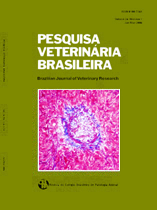 |
|
|
|
Year 2010 - Volume 30, Number 5
|

|
Epidemiological aspects and hepatic lesions pattern in 35 outbreaks of Senecio spp. poisoning in cattle in southern Brazil, 30(5):389-397
|
ABSTRACT.- Grecco F.B., Schild A.L., Soares M.P., Marcolongo-Pereira C., Estima-Silva P. & Sallis E.S.V. 2010. [Epidemiological aspects and hepatic lesions pattern in 35 outbreaks of Senecio spp. poisoning in cattle in southern Brazil.] Aspectos epidemiológicos e padrões de lesões hepáticas em 35 surtos de intoxicação por Senecio spp. em bovinos no sul do Rio Grande do Sul. Pesquisa Veterinária Brasileira 30(5):389-397. Laboratório Regional de Diagnóstico, Faculdade de Veterinária, Universidade Federal de Pelotas, Campus Universitário, Pelotas, RS 96010-900, Brazil. E-mail: alschild@terra.com.br
The study aimed to characterize morphological patterns of 59 liver samples of Senecio spp. poisoned cattle from 35 outbreaks, observed in southern Rio Grande do Sul, Brazil, from 2000 to 2009. The lesions were associated with epidemiological changes during these years. The climate changes concerning accumulated rain and mean temperature during the different seasons were analyzed. The macroscopic and histological lesions were classified into 6 different patterns. The macroscopic classification was made according to capsular pattern, hepatic cut surface discoloration, and the presence of nodules. The histological classification was based on the distribution of fibrosis, the amount of megalocytes in 10 high magnification fields, and on bile duct proliferation. Pattern 1 was characterized by a whitish liver, diffuse fibrosis, severe bile duct proliferation, and discrete megalocytosis; pattern 2 was characterized by nodules consisting of groups of hepatocytes surrounded by fibrosis, severe bile duct proliferation, and discrete to mild megalocytosis; pattern 3 was characterized by a macro-nodular aspect to the cut surface with hepatic lobules surrounded by a thin septa of fibrous tissue, severe bile duct proliferation, and mild megalocytosis; pattern 4 was characterized by a non-nodular surface with marble aspect, mild to severe bile duct proliferation, and megalocytosis; pattern 5 was characterized by a non-nodular surface and bridging or diffuse fibrosis, mild megalocytosis, and severe bile duct proliferation; and pattern 6 was characterized by a non-nodular surface, severe megalocytosis, discrete bile duct proliferation, and incipient fibrosis of the portal system, central vein or among hepatocyte cords. The results of macroscopic and histological liver analysis showed that patterns 1, 2 and 4 were the most frequently observed. The results of this study demonstrated that the macroscopic lesion observed in Senecio poisoned cattle is variable. Histologically this variation is related to the amount and distribution of fibrosis, megalocytosis and bile duct proliferation observed in each liver. Age of the cattle, evolution period of poisoning and clinical signs did not interfere on the pattern of lesions observed. On the other hand, climatic conditions probably had influence on increased disease prevalence due to major availability of Senecio spp. plants. |
| |
|
|
| |
|
 |